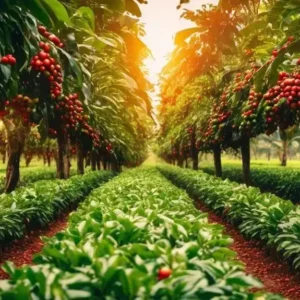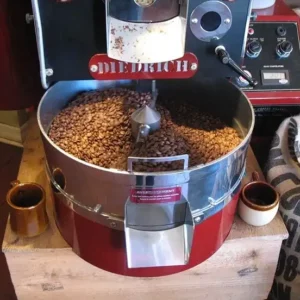Have you ever wondered what really happens to Excelsa coffee beans during the roasting process? Many theories abound about the chemical reactions and transformations that take place, but what is the truth behind it all?
Understanding the chemistry of Excelsa roasting is crucial to unlocking the full potential of this unique coffee variety. As you explore the intricacies of this process, you'll gain insight into the complex interplay of compounds that ultimately shape the flavor and aroma of your favorite cup of coffee.
So, let's delve into the world of Excelsa roasting and uncover the fascinating chemistry behind it all.
Chemical Reactions During Roasting

During roasting, coffee beans undergo complex chemical reactions that transform their flavor and aroma profiles. The roasting chemistry of Excelsa coffee beans is a fascinating journey of chemical changes that ultimately result in a sensory experience like no other.
As the beans heat up, a Maillard reaction occurs, leading to the formation of hundreds of different compounds that contribute to the flavor complexity of the final brew. This reaction is responsible for the creation of those rich, caramel-like flavors and deep aromas that Excelsa is known for.
Additionally, during the roasting process, the beans undergo pyrolysis, where heat breaks down complex sugars and carbohydrates, leading to the creation of various aromatic compounds. These compounds play a crucial role in the sensory experience of the coffee, tantalizing your taste buds with their unique and captivating flavors.
Understanding the intricate chemistry behind roasting is essential in unlocking the full potential of Excelsa coffee, allowing for innovation and the creation of unparalleled sensory experiences for coffee enthusiasts.
Formation of Aromatic Compounds
The complex chemical reactions occurring during the roasting of Excelsa coffee beans lead to the formation of a diverse array of aromatic compounds that contribute to its distinctive flavor and aroma profiles. As the beans undergo roasting, a fascinating array of aromatic compounds is synthesized.
The Maillard reaction, for instance, plays a pivotal role in generating these compounds, resulting in the creation of key flavor precursors such as furans, pyrazines, and thiophenes. These compounds are responsible for the development of the coffee's rich and complex flavor profile, offering a symphony of nutty, fruity, and floral notes that tantalize the taste buds.
Additionally, the breakdown of chlorogenic acids during roasting yields quinic acid and various caffeic acid derivatives, adding further layers of complexity to the coffee's aroma and taste. The formation of these aromatic compounds is a testament to the intricate chemistry at play during the roasting process, showcasing the remarkable ability of Excelsa coffee to deliver an innovative and multi-dimensional sensory experience.
Impact of Temperature on Flavor Development

When you roast coffee beans, temperature plays a crucial role in determining the flavor profile. As the beans heat up, chemical reactions occur that directly impact the taste and aroma of the resulting brew.
Understanding how different temperatures influence flavor development is key to achieving the perfect roast for the desired flavor profile.
Temperature and Flavor
How does temperature affect the development of flavor in the roasting process?
Roasting techniques and temperature control play a pivotal role in flavor development through a series of complex chemical reactions.
As the temperature rises during the roasting process, the Maillard reaction occurs, leading to the formation of aromatic compounds that contribute to the coffee's flavor profile.
Moreover, temperature influences the rate of various chemical reactions, impacting the breakdown of sugars and the formation of desirable flavor compounds.
Optimal temperature control is crucial for achieving the desired flavor profile, as subtle adjustments can significantly impact the final taste of the coffee.
Understanding the interplay between temperature and flavor development is essential for pushing the boundaries of coffee roasting and unlocking new and innovative flavor profiles in Excelsa coffee.
Heat and Taste
Exploring the impact of temperature on flavor development in Excelsa coffee roasting reveals the intricate relationship between heat and taste, shaping the unique flavor profiles through a complex interplay of chemical reactions. Heat transfer during roasting significantly influences the sensory perception of the resulting coffee. The table below illustrates the effects of different roasting temperatures on the sensory attributes of Excelsa coffee:
| Roasting Temperature | Sensory Attributes |
|---|---|
| Low | Bright acidity, floral |
| Medium | Balanced, nutty |
| High | Rich, dark chocolate |
| Very High | Bitter, smoky |
| Extremely High | Burnt, astringent |
As the roasting temperature increases, the flavor profile evolves, resulting in a diverse range of sensory experiences. Understanding the impact of heat on taste is crucial for crafting the distinct flavors that Excelsa coffee enthusiasts seek.
Influence on Aroma
The roasting temperature significantly influences the aroma, shaping the distinctive fragrance of Excelsa coffee through a complex interplay of chemical reactions. As the temperature rises, a myriad of chemical transformations occur, ultimately impacting the aroma development and the overall sensory experience of the coffee.
Here are the key ways in which temperature influences aroma development:
- Maillard Reaction: Higher temperatures intensify the Maillard reaction, leading to the formation of aromatic compounds that contribute to the coffee's complex aroma profile.
- Degradation of Precursors: Elevated temperatures facilitate the breakdown of precursor molecules, giving rise to the development of specific aroma compounds.
- Volatile Compound Formation: Increased heat encourages the generation of volatile compounds, which play a pivotal role in shaping the aroma characteristics.
- Oxidation Processes: Temperature influences oxidation, affecting the formation of aroma-active compounds from lipid oxidation and other reactions.
Maillard Reaction and Excelsa Coffee

When roasting Excelsa coffee, the Maillard reaction plays a crucial role in developing its unique flavor profile. This reaction occurs between amino acids and reducing sugars, resulting in the complex browning and flavor formation that distinguishes Excelsa coffee.
Understanding the Maillard reaction basics is key to appreciating the distinct and rich flavor that Excelsa coffee brings to the table.
Maillard Reaction Basics
The Maillard reaction, essential for flavor formation in roasting, plays a crucial role in developing the rich and complex taste of Excelsa coffee. Here's what happens during this chemical process:
- Aroma Development: The Maillard reaction leads to the production of various aromatic compounds, contributing to the enticing aroma of Excelsa coffee.
- Flavor Enhancement: It results in the formation of new flavor compounds, adding depth and complexity to the coffee's taste profile.
- Color Transformation: The Maillard reaction causes the beans to undergo a color change, leading to the characteristic deep and dark hue associated with Excelsa coffee.
- Texture Improvement: It also impacts the texture of the beans, influencing the mouthfeel and overall sensory experience of the brewed coffee.
The Maillard reaction truly elevates the appeal of Excelsa coffee through its multifaceted effects.
Excelsa Coffee Flavor
Excelsa coffee's unique flavor profile is intricately shaped by the Maillard reaction, infusing it with rich aromas and complex taste notes.
The origins of Excelsa coffee play a significant role in its flavor profile. Grown predominantly in Southeast Asia, particularly in regions like the Philippines and parts of Indonesia, the coffee cherries from the Coffea excelsa plant develop a distinct taste due to the specific climate and soil conditions in these areas.
The flavor profiles of Excelsa coffee often boast a harmonious blend of fruity, floral, and smoky notes, making it a standout choice for those seeking a diverse and innovative coffee experience.
The Maillard reaction, occurring during the roasting process, contributes to the development of these intricate flavor characteristics, distinguishing Excelsa coffee in the world of specialty coffees.
Role of Caffeine and Acidity in Roasting
Understanding the impact of caffeine and acidity on the roasting process is essential for achieving the desired flavor profile in coffee beans. When it comes to Excelsa coffee, the role of caffeine and acidity is particularly intriguing due to its unique flavor characteristics.
Here's a closer look at the significance of caffeine and acidity in the roasting process:
- Caffeine Extraction: The roasting process affects the extraction of caffeine from the coffee beans, influencing the overall caffeine content in the final brew.
- Acidity Balance in Roasting: The interaction between acidity and roast level is crucial in determining the overall flavor profile of Excelsa coffee, as it can either enhance or diminish the natural acidity of the beans.
- Flavor Development: Caffeine and acidity play a pivotal role in flavor development during roasting, contributing to the complex and distinct taste of Excelsa coffee.
- Chemical Changes During Roasting: Understanding the chemical changes that occur during roasting is vital for manipulating the levels of caffeine and acidity to achieve the desired flavor characteristics.
Understanding Roast Profiles and Variations

Exploring various roast profiles and their unique variations can provide valuable insights into the diverse flavor nuances present in Excelsa coffee. Roast color and flavor are key indicators of the complex chemical changes that occur during roasting. Lighter roasts tend to preserve the bean's natural flavors and acidity, resulting in a bright and vibrant cup, while darker roasts bring out deeper, smokier notes. Understanding the impact of roast color on flavor can help you tailor your roasting process to achieve specific taste profiles.
Bean moisture and development play pivotal roles in shaping roast profiles. The initial moisture content of the green bean influences the rate of development and the final flavor. Monitoring the bean's moisture levels throughout the roasting process is crucial for achieving consistent results. Additionally, understanding the development stage, from first crack to the desired roast level, allows you to control the evolution of flavors and aromas in the coffee.
Influence of Roasting Time on Excelsa Flavor
Bean moisture levels and development, which were previously discussed, significantly influence the flavor of Excelsa coffee during the roasting process. Roasting time plays a crucial role in flavor development, as it directly impacts the chemical reactions taking place within the coffee beans. Here's how roasting time influences the flavor profile of Excelsa coffee:
- Chemical Reactions: Longer roasting times lead to the Maillard reaction and caramelization, intensifying the flavor and aroma of Excelsa coffee. This results in the development of rich, complex flavor profiles with hints of nuttiness and spice.
- Aromatic Compounds: Extended roasting times allow for the generation of a broader spectrum of aromatic compounds, contributing to the formation of unique flavor notes such as dark chocolate and earthy undertones in Excelsa coffee.
- Flavor Development: The duration of roasting directly impacts the balance between acidity and bitterness in Excelsa coffee, with longer roasts yielding a bolder, more robust flavor profile.
- Optimal Timing: Finding the optimal roasting time is crucial for unlocking the full potential of Excelsa coffee, as it allows for the precise control of flavor development and ensures a consistently exceptional cup of coffee.
Conclusion
So, next time you enjoy a cup of excelsa coffee, remember the complex chemical reactions that took place during roasting to create its unique flavor profile.
And while some may argue that the science behind roasting takes away from the simple pleasure of enjoying a cup of coffee, understanding the chemistry can actually enhance your appreciation for the art and skill that goes into creating the perfect roast.









